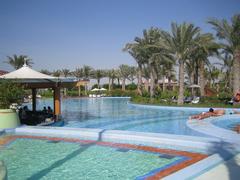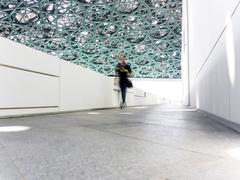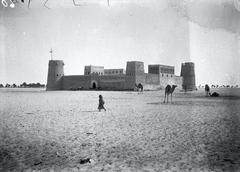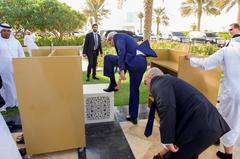Hili Archaeological Park: Visiting Hours, Tickets, and Essential Guide to Al Ain Historical Sites
Date: 04/07/2025
Introduction
Nestled in the heart of Al Ain, Abu Dhabi, Hili Archaeological Park stands as a beacon of the United Arab Emirates’ ancient heritage. As the largest Bronze Age site in the UAE and part of the Al Ain UNESCO World Heritage Site, Hili offers a unique, immersive journey through more than 4,000 years of continuous human settlement. From monumental tombs and early irrigation systems to family-friendly gardens and educational exhibits, the park is both a cultural treasure and a welcoming public space. This comprehensive guide covers everything you need to plan your visit, including opening hours, ticket information, accessibility, and nearby attractions.
Contents
- Introduction
- Historical Overview & Significance
- Major Archaeological Discoveries
- The Grand Tomb
- Burial Structures
- Settlement Remains
- Falaj Irrigation System
- Artifacts & Material Culture
- Visitor Information
- Visiting Hours
- Entry & Ticketing
- Guided Tours
- Accessibility
- Getting There
- Facilities
- Experience & Attractions
- Gardens & Landscaped Areas
- Educational Displays
- Family & Recreational Amenities
- Events & Cultural Activities
- Photography
- FAQs
- Conclusion
- Sources
Historical Overview & Significance
Hili Archaeological Park is a key component of the Al Ain UNESCO World Heritage Site, reflecting the region’s pivotal role in early urbanization, agriculture, and trade networks during the Umm an-Nar culture (c. 2500–2000 BCE) (uaestories.com). Excavations since the 1960s have uncovered settlements, tombs, and irrigation systems, revealing advanced social and technological development in the Bronze Age Arabian Peninsula.
Major Archaeological Discoveries
The Grand Tomb
The Grand Tomb is the park’s most iconic structure—an imposing circular burial site measuring 12 meters in diameter and 4 meters high. Built with finely cut limestone and adorned with engravings of humans and animals, this monument encapsulates the complexity and communal traditions of the Umm an-Nar culture (Odyfolio Emirates).
Burial Structures
Beyond the Grand Tomb, the park features several smaller tombs and burial mounds, constructed from local stone. These multi-chambered tombs reflect family or clan-based customs, with grave goods such as pottery, jewelry, and bronze tools indicating trade and social status.
Settlement Remains
Remnants of houses, storage rooms, hearths, and community spaces provide a window into daily life. The use of mudbrick and stone demonstrates adaptation to the harsh desert climate, and the site’s organization suggests a well-planned settlement.
Falaj Irrigation System
Hili’s ancient falaj—underground irrigation channels—are among the earliest examples in Arabia. These systems brought water to agricultural fields, showcasing the ingenuity of early desert societies (Wikipedia).
Artifacts & Material Culture
Pottery with geometric motifs, bronze weapons, beads, and imported items from the Indus Valley and Mesopotamia highlight Hili’s role in regional and international trade networks.
Visitor Information
Visiting Hours
Hours may vary slightly by season and source, but Hili Archaeological Park is generally open daily from 7:00 AM to midnight, with some references listing 8:00 AM to 6:00 PM or 9:30 AM to 6:30 PM (Abu Duba; Property Finder). It is advisable to confirm current timings via the Department of Culture and Tourism – Abu Dhabi.
Entry & Ticketing
Admission is free for all visitors, making the park an accessible destination (Property Finder).
Guided Tours
Guided tours, available upon request through local tourism offices and the Department of Culture and Tourism, provide expert insights into the site’s history and discoveries.
Accessibility
The park is wheelchair-friendly with flat, paved paths, accessible restrooms, and shaded seating. Family amenities and inclusive signage make it accessible for all ages and abilities (Abu Duba).
Getting There
Located about 10–15 km north of central Al Ain, Hili Archaeological Park is best accessed by car or taxi. Ample free parking is available onsite. Public transport options are limited (Al Maya UAE), so private vehicles are recommended.
Experience & Attractions
Gardens & Landscaped Areas
The park’s lush date palms, fountains, and landscaped gardens provide a tranquil oasis for visitors, blending natural beauty with archaeological significance (Visit Abu Dhabi).
Educational Displays
Informative signage in Arabic and English, along with interactive exhibits in the onsite museum, offer context about the Bronze Age structures, artifacts, and the people who inhabited the region (4Hili.com).
Family & Recreational Amenities
- Children’s Playgrounds: Safe, well-equipped play areas.
- Picnic and BBQ Zones: Shaded tables and grassy lawns.
- Sports Facilities: Basketball courts and open fields.
- Restrooms & Drinking Water: Well-maintained and easily accessible.
Events & Cultural Activities
The park occasionally hosts cultural events, heritage festivals, and educational workshops. These provide immersive opportunities to engage with the UAE’s ancient traditions. Check the official site or uaestories.com for updates.
Photography
Hili Archaeological Park offers excellent photography spots, especially around the Grand Tomb and gardens. Early morning and late afternoon light are ideal for capturing the site’s ambiance.
Frequently Asked Questions (FAQ)
Q: What are the park’s visiting hours?
A: Generally 7:00 AM to midnight, but confirm via official sources before visiting.
Q: Is there an entry fee?
A: No, entry is free for all visitors.
Q: Are guided tours available?
A: Yes, through local operators or the Department of Culture and Tourism.
Q: Is the park wheelchair accessible?
A: Yes, with paved paths and accessible facilities.
Q: Can I bring children?
A: Absolutely. The park has playgrounds and family-friendly spaces.
Q: Are pets allowed?
A: Pets are generally not permitted.
Q: Can I take photographs?
A: Yes, photography is encouraged—respect site guidelines.
Q: What should I bring?
A: Sunscreen, water, comfortable shoes, and a hat are recommended.
Conclusion
Hili Archaeological Park is a rare fusion of ancient history and modern hospitality, making it a cornerstone of cultural tourism in Abu Dhabi. With its monumental tombs, ancient settlements, and innovative irrigation systems, the park brings the Umm an-Nar culture and early Arabian civilization vividly to life. Free entry, family-friendly amenities, accessible facilities, and year-round events ensure a rewarding experience for all. To enrich your visit, consider guided tours and explore nearby attractions like Al Ain Oasis and Al Jahili Fort.
Stay informed about special events and ongoing discoveries by visiting the Department of Culture and Tourism – Abu Dhabi, uaestories.com, and the Al Ain Tourism website.
Enhance your experience: Download the Audiala app for curated guides, event alerts, and exclusive cultural content. Follow us on social media and share your discoveries at Hili Archaeological Park!
Sources
- Hili Archaeological Park: A Complete Visitor’s Guide to Al Ain’s Historic Bronze Age Site, 2024, uaestories.com
- Hili Archaeological Park: Visiting Hours, Tickets, and History of Al Ain’s Largest Bronze Age Site, 2024, Odyfolio Emirates
- Hili Archaeological Park Visiting Hours, Tickets & Guide to Al Ain Historical Sites, 2025, Abu Duba
- Hili Archaeological Park Official Page, Department of Culture and Tourism – Abu Dhabi
- Hili Archaeological Park: Exploring the Ancient Wonders of Hili Archaeological Park in Abu Dhabi, 2024, 4Hili.com
- Hili Archaeological Park, Wikipedia, 2024
- Hili Archaeological Garden, Visit Abu Dhabi
- Hili Archaeological Park, Property Finder
- Hili Archaeological Site, Al Maya UAE
- Hili Archaeological Park: A 5000-Year Journey Through UAE History, History Tools






